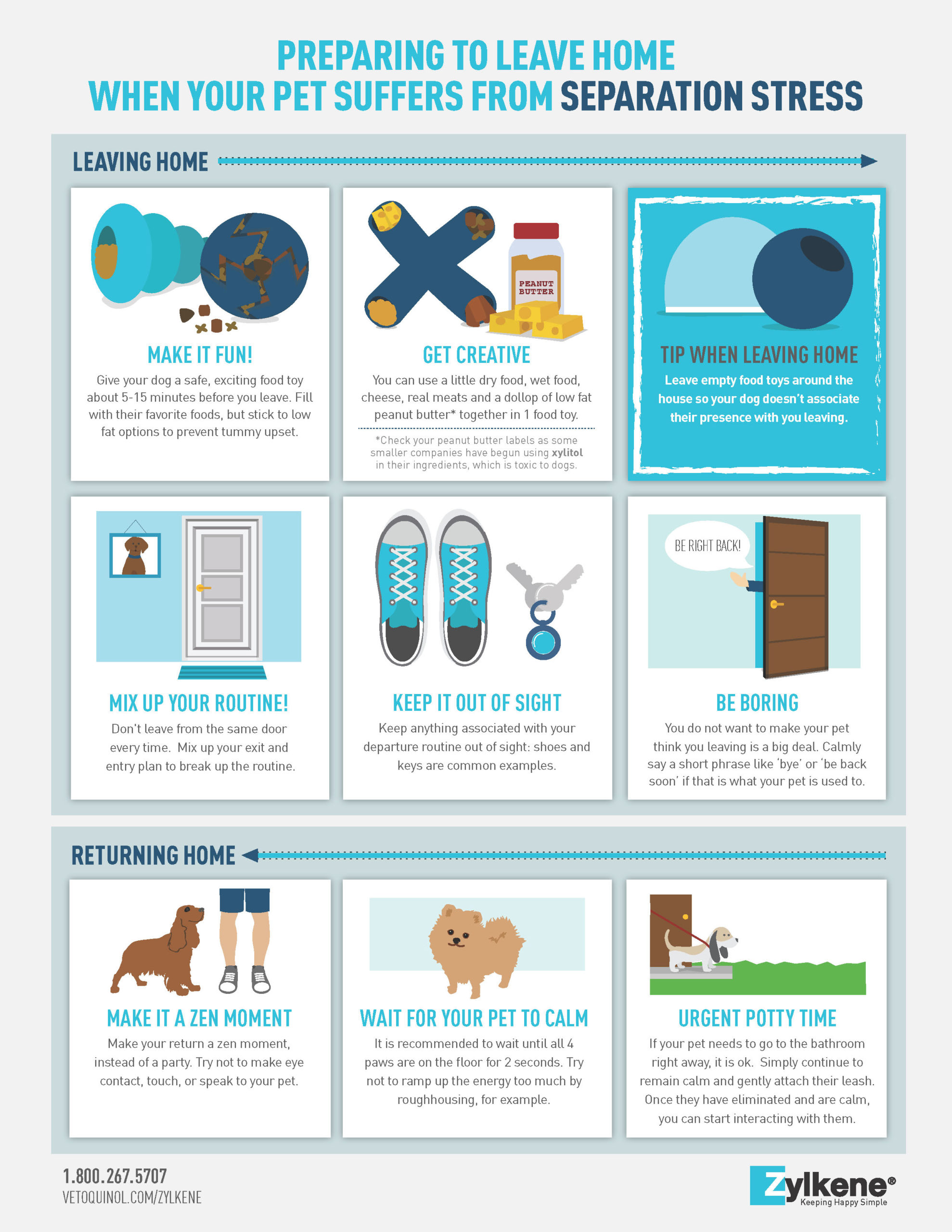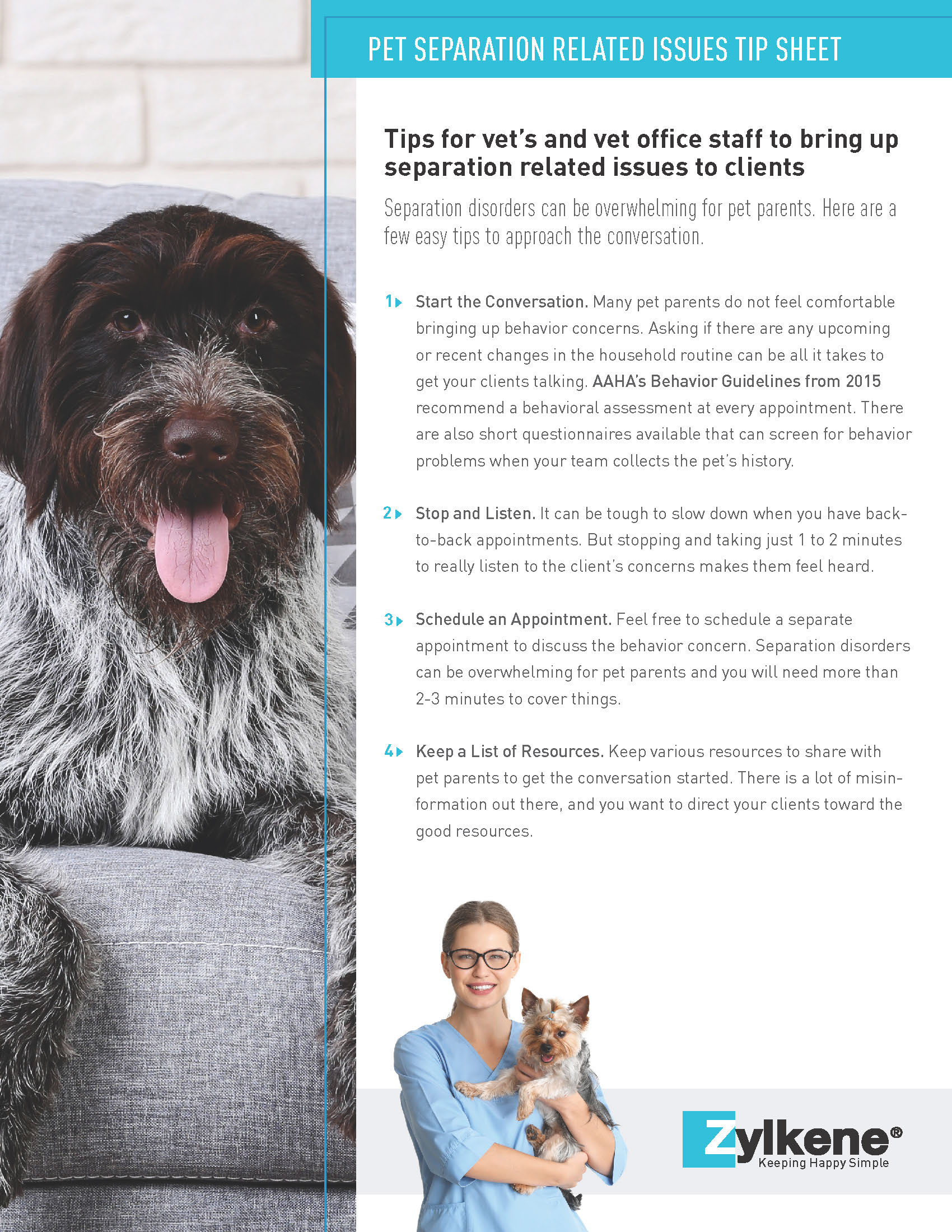Separation Toolkit
We are happy to provide you with the Separation Digital Toolkit, a resource that makes it easy to maintain timely, relevant communications with pet parents. The Vetoquinol team is dedicated to helping pets and improving the clinic experience for you and your clients. This digital toolkit is just one of the ways we use our passion for animal health to help you grow your business.
The Separation Digital Toolkit includes the following:
- 5 articles written by our veterinarians for use on your website, blog or in newsletters
- An infographic designed for pet parents
- A tip sheet for use in your practice
We hope you find this toolkit to be a valuable resource for your practice. Please feel free to contact your Vetoquinol USA Sales Representative with any questions.
Blog Post Articles
Use the professionally-written articles below on your website, blog, or in your newsletter.
About Separation
Separation related disorders are some of the most common behavior disorders in pets; they are estimated to affect at least 14% of dogs in the United States. These conditions have also been identified in cats. They can present in a variety of ways. Some pets show distress when a particular person is gone, others when all people depart, and still others when there is a barrier between them and others.
The specific causes are still unclear. Dogs are often seen as a more social species than cats, but both form strong bonds with social group members. It is proposed that vocalizations such as whining, barking, and howling are used to reach out to other social group members.
Multiple studies have shown that separation disorders are more common in dogs and cats without experience being alone, that follow their pet parents constantly, and those with a change in household routine. Changes in routine can be minor or major. Some typical situations are after someone leaves the house more after an extended period at home, when someone leaves or joins the household, or after the family has moved. Separation disorders can also arise after something frightening has happened in the family’s absence, such as a thunderstorm or fireworks. Older pets are less able to adapt to change and may develop separation disorders as a result. Additionally, there can be significant overlap between pets that show distress when alone and those that show distress during storms or loud noises. Since it isn’t unusual for pets to have fear of noises as well as separation issues, it is important to carefully assess for both conditions when evaluating one of them.
The clinical signs of a separation disorder vary from one pet to another. Vocalization (barking or howling), destruction, urination, and defecation are the most obvious and also the most commonly reported. Pets frequently show other clinical signs as well, which may not be noticed as readily. Some of these other signs include salivation, whimpering, pacing, and panting. In some pets these signs can be seen before the family leaves the home, but for others they only occur after the pet is completely alone. Taking an excessively long time to calm down when the family returns is another common sign.
What to Do If Your Animal Has Destructive Behaviors While Away (And How to Prevent Them)
Destruction is one of the most commonly reported signs of separation disorders, and it is easy to see why. Unless your home shares walls with others, you may not be aware of barking or whining. It is tough to miss damaged furniture, though.
Chewing and scratching may be focused on exit points, like doors or windows. In some cases the target is only the door where the family leaves and returns. Destruction can vary from minor to severe. The actual damage and cost to repair it is a major concern, but it can also be dangerous for your pet. Some common injuries include broken nails and teeth, cuts, and ingestion of furniture or building materials.
If your pet is destructive when you are gone, here are some steps you can take:
- Take a deep breath. It is normal to be dismayed, frustrated, and even angry when you come home to damage. Keep in mind that your pet absolutely has not done this because they are angry, or out of spite. Pets often seek out items that smell like family members, but this is not retaliation. Punishing your pet will not make the situation any better and in fact can make things considerably worse.
- Get a video camera. Actually seeing what your dog’s body language is like when they are alone can help figure out whether the reason for the behavior is distress at being alone, reacting to things outside the house, or even a housetraining issue. Each of these problems requires a different treatment approach, so this is invaluable information. It does not need to be longer than 30 minutes. If you already know that your pet’s distress is severe, either skip this step or keep your departure <10 minutes.
- Providing plenty of activities to keep your pet busy while you are gone is always a great idea. There are endless possibilities available, from challenging puzzle toys found online to do-it-yourself options. Destructive pets can respond well to having something appropriate to tear up, like a box stuffed with crumpled paper with tiny treats sprinkled inside. Giving your pet somewhere to focus their energy can be a game changer.
- Sometimes pets need to be confined to ensure their safety. If your pet is already crate trained and really loves their crate, using that may be a good option. For many pets, however, being confined to a crate or a room increases their stress levels. Use the camera to see how your pet tolerates this. If they are distressed or attempt to escape, reach out for help (see next tip). If your dog enjoys daycare, taking your pet there when you leave can prevent damage while you work on a treatment plan.
Speak to your vet. Describe what you are seeing and share any videos you have when your pet is alone. Depending on your pet’s signs, they can make recommendations for pheromones, supplements such as Zylkene, or pharmaceutical options if appropriate. They may recommend a referral to a veterinary behaviorist, who specializes in these types of problems.
How to Change Your Routine (Like Back to School and Work) Without Causing Stress to Your Pet
If you know you have a change in your routine coming up, here are some steps you can take to ease the transition for your pet.
- Gradually shift your morning routine to match the new one. This is an important step when you go back to work after an extended period at home, for example. A simple way to do this is to start waking up earlier every couple of days until you reach your new wake up time.
- If you walk your dog, shift the timing to match the upcoming change in routine.
- Start to leave the house for longer periods so they can get used to being alone again. Even going for a drive is a good start. If your pet shows significant signs of stress with this change, speak to your vet before your new routine starts.
- Get in the habit of leaving your pet with something to do. Don’t underestimate the power of food! A delicious food toy is all it takes for some pets to switch from concerned about you leaving to wondering when you will get out of the house!
- Keep your departures and returns home low key. Instead of lavishing your pet with attention, you want these times to be boring. This helps teach that departures and returns are no big deal.
Talk to your vet about other options to help your pet adjust. Products like pheromones or supplements such as Zylkene work best when started at least a couple of days before the new routine starts. If your pet has a history of distress when left alone, start working with your vet right away.
Activities and Exercises to Help Prevent Separation Stress
There is little data available on how to prevent the formation of separation disorders. This is at least in part because the causes are still unclear. There are probably multiple factors at play.
Veterinary and animal behaviorists do recommend encouraging independence in your pet. It can be nice to feel needed, but it is important for your pet to be able to function when you are not present.
When your pet chooses to rest across the room from you, instead of at your feet, reward them. Tossing very small treats can work well. If your pet gets too excited about treats, then calm verbal praise can work. Do the same when your pet chooses to spend time in a different room than you.
Make alone time fun! Get your pet used to having some alone time every day. This can be in an enclosed room, their crate, or behind a baby gate. Give them a delicious stuffed food or puzzle toy to make this a fun time. You also want to get used to giving them an activity before you leave the house.
If your pet shows distress when they cannot get to you, or when you leave the house, speak to your vet about options. The problem is unlikely to get better on its own.
Adding another pet to the home is rarely successful for reducing or eliminating separation related behaviors. This is not recommended unless the family was already hoping to add a furry family member.
Questions and Topics to Discuss With Your Vet
- Ask your vet whether there could be an illness causing your pet’s change in behavior. They will likely want to do some tests to rule out common medical conditions.
- Where can I go to get helpful information about this problem?
- Is this something that my pet will outgrow or get used to?
- Discuss your comfort level with giving your pet any behavioral supplements or pharmaceuticals. What concerns or reservations do you have?
- What medication or supplement options are available to help with this problem?
- Have a conversation about what treatment success might look like for your pet.
- Ask what you should be doing to track the response over time (ex. keep a behavior journal, collect videos of your pet, etc.)
- Ask how long it might realistically take to see some improvement with the treatment plan you have chosen.
Understand that treating behavioral problems sometimes involves a little trial and error to see what works best for each individual pet. Good communication between you and your veterinarian can significantly help improve this process for your pet!


